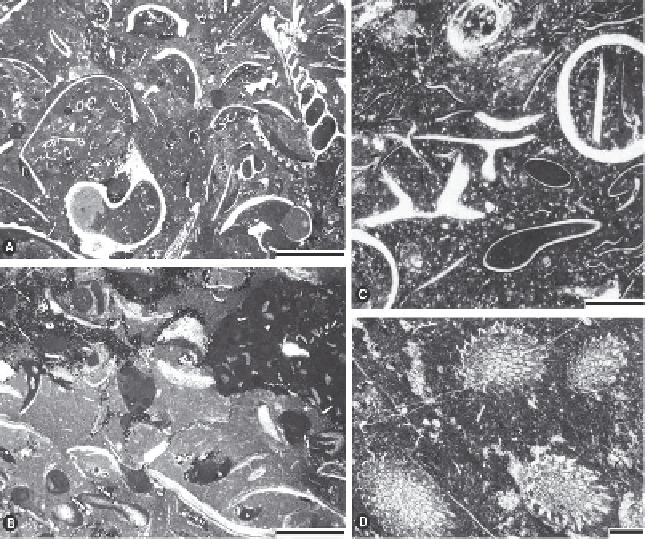Geology Reference
In-Depth Information
Plate 117 Standard Microfacies Types: SMF 8 and SMF 9
SMF 8. Wackestones and floatstones with whole fossils and well preserved infauna and epifauna
Criteria:
Predominantly sessile organisms rooted in micrite and some mobile organisms. The micrite con-
tains scattered, often very small skeletal debris contributing to a finely bioclastic matrix. Burrowing is common.
Many fossils are well preserved (e.g. double-valved mollusks), but some isolated fragments may occur. Charac-
teristic organisms are mollusks, sponges, corals and some calcareous algae.
Occurrence
: Shelf lagoon with
circulation. Low-energy environments below wave base (FZ 2 and FZ 7). Outer and mid-ramp settings. The
sediment is formed in quiet water below the fair-weather wave base.
Additional pictures:
Pl. 44/3, Pl. 86/1, Pl.
88/1, Pl. 89/1.
SMF 9. Strongly burrowed bioclastic wackestone
Criteria:
Micrite with common to abundant fragmented fossils that are jumbled through burrowing. Bioclasts
often micritized. Common fossils in Paleozoic limestones are crinoids, brachiopods, bryozoans, and scattered
rugose corals. Mesozoic and Tertiary examples are characterized by bivalves, gastropods, and echinoderms.
Occurrence:
Shallow lagoon with open circulation at or just below the fair-weather wave base (FZ 7) and deep
shelf (FZ 2); outer and mid ramp settings.
Additonal pictures:
Pl. 19/1, Pl. 44/2.
1
SMF 8.
Whole fossil wackestone/floatstone.
The sample shows solenoporacean red algae (SA,
Parachaetetes
), corals (C)
and a few dasyclad algae (DA,
Jodotella
), as well as foraminifera (F) and bored shells (S). Most fossils are well preserved
and show no signs of reworking. This SMF is common both in the deep open shelf environment (FZ 2) and in shallow
open shelf lagoons (FZ 7). The presence of calcareous algae supports the attribution to FZ 7. Early Tertiary (Paleocene):
Kammbühl near Ternitz, Austria.
2
SMF 9.
Burrowed bioclastic wackestone/floatstone.
Fossils are fragments of gastropods (G), corals (C), and foraminifera
(F). White arrows point at burrows filled with fecal pellets and foraminifera. The interpretation as fecal pellets is sup-
ported by the dark color and the marked bimodal grain size. The matrix is a fine-grained pelmicrite, in parts pelsparite.
The stratigraphic sequence reflects a tropical lagoon surrounded by coral reefs. Thin-bedded, platy bituminous micrites
without benthic fossils but rich in fishes represent the lagoonal center. Bedded limestones with larger foraminifera and
mollusks (this sample) represent the shallow part of the lagoon. The composition of the gastropod fauna reflects changes
from open-marine to more restricted conditions. Early Tertiary (Eocene): Pesciara, Monte Bolca, Verona, northern Italy.
Fig. 14.19. SMF 8:
Bioclastic wacke-
stones and floatstones.
Many samples
of the SMF Type 8 are characterized
by bioclastic wackestones and float-
stones with various shells (A, B, C)
and/or by nearly monospecific biota
(D). An other common criterion is the
fine-bioclastic micrite matrix.
A:
Bivalve-gastropod wackestone.
Normal marine, low-energy, shallow
subtidal environment. Facies zone FZ
7. Late Cretaceous (Turonian): Sinai,
Egypt.
B:
Bivalve floatstone. The shells occur
together with rounded micritic intra-
clasts (center). Note large burrow at
the top right. Protected shallow sub-
tidal environment. Mid-ramp setting
(FZ 7). Locality as in A.
C:
Bioclastic floatstone with hyolithid
shells (see Fig. 10.47) and trilobite
fragments (bottom right). The matrix
is a quartz-bearing burrowed pel-
micrite. Deep shelf environment (FZ
2). Cambrian (Wadi Nasb Limestone
Formation): Wadi Al Ghadaf well,
eastern Jordan.
D:
Wackestone with the tabulate coral
Thamnopora
. The matrix is a fine-bioclastic pelmicrite. FZ 7, open-
marine lagoon behind a stromatoporoid-coral reef. Late Devonian (Frasnian): Carnic Alps, Italy. Scale for all figures 2 mm.
A and B: Bauer et al. (2002); C: Shinaq and Bandel (1992); D: Galli (1985).

